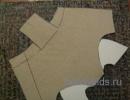Master class crocheted watches. Crocheted toy watches How to crochet a watch
translated text
Pattern (all lines in alternating blue and white threads):
6 h and form a ring with 1 SL. Don't delay! The void in the center should be large enough to stick to the clock you want to set then passes.
Round 1: 12 DC in ring
Row 2: 2 pieces in each row to the end = 24
Row 3: (1st, 2 dc in next m) row = 36
Row 4: (2 dc, 2 dc in next st) to end = 48
Row 5: (3 dc, 2 dc in next st) to end = 60
Row 6: (4 dc, 2 dc in next st) to end = 72
Row 7: (5 dc, 2 dc in next st) row = 84
and so on.
I already purchased a yarn card from Make Creation and 24 different colors. I used double yarn for the background and yarn for everything else. I also bought the movements there, as well as the buttons and felt the numbers.
Urverkets long needle was 11 cm (the second hand is 1 cm longer, but extends as far as the minute hand).
Once the work was how long the needle was, and then some (I stopped at 12cm), I started changing the colors of the rainbow.
then crochet in the same way, but changing the color of each row until the clock is as big as you want it.
There are many videos showing the best way to change colors.
several links here: Yarn Studio, MiA Mini Spiration,
NeedleNoodles, Virkskolan

The very last crochet row is 4 DC, 1 picot CH 3, 4 DC etc. contract.
then I drew all the threads and stroked the medallion so it was smooth and good.
When I clearly knew the knitted ones would also be like a large background. It's not easy to know in advance, it depends on both the thickness of the twine and the crochet firm.
I have a handy guy, so I asked him to cut the right diameter into a piece of Masonite and drill a hole in the middle. Caution The hole in the center must be large enough to stick to the winding is going through. There, I forgot, so I had it a little awkward to correct it later. Again, it's a blessing that I have a handy person who can drill the hole without damaging the front panel.
To get a good surface and not let the brown show through the crochet, I painted them white on the front and back.
While they're drying, it's time to crochet the flowers!

Flowers
There are various free patterns for crochet flowers. Just pick a few that you like best.
Some of them can be found here: Yarn Studio, Most Crochet, King and Majkis, Piercing, Create and Decorate, Attic24, Molly Does
If you want to watch movies how to do this, there are many to choose from as well: Drops Design , epicabundance And a number of others.
Just let your imagination run free, mix varieties and colors as much as you want!
Butterflies
For the butterfly, I found a very nice template that Marie Pedersen from Silk & Burg made.
Marie has many good photos showing how to do this.
The template translated into Swedish looks like this:
(1st post, as usual, CH 3)
Row 1 - (3 DC, CH 2) 8 times per magic circle, 1 SL-th in the first street.
Row 2 - 1, (DC 3, CH 2, 3 DC) in the air loop at 2 CH from the previous round. Repeat 8 times, but the last time you finish with 2 instead of 3 and SL th in first ST = 8 groups of 3 DC, CH 2, 3 DC.
Round 3 - (8 pieces in LMB from the previous round, 1 SL in the gap between the poles of the group in the previous row) 8 times. 1 SL-th in the first street. = 8 groups of 8 pieces.
leave a long thread, cut the thread and pull it through the last stitch.
Fold in half and sew.
Make antennas on a 15 lm hook, fold and sew the remaining threads. Attach and cut.
I made my antennas wired with a simple garnbit instead.
You can make it with multi-colored butterflies, changing the color after the second circle.
I patted a little glue onto the stick "antennas" to stiffen them a little and keep them from cutting out until they were dry. You can also do like Marie: twisting wire antennas together!
LADYBIRD
I found the ladybug on myself, free samples can be found.

Ladybug I sewed on the second hand with
several stitches on the front and back.

I glued the numbers solid, and then it was just a matter of laying flowers,
where I (well, Annie had a pretty good idea too) wanted them.
It's important to think about leaving your hands free, so that they don't later get stuck in some colors.
I sewed flowers and buttons, rather than doing what Matt did and gluing them there.
In some colors, I chose to attach them instead of beads.

Then I wiped a stick of glue onto the background molded into the crocheted watch and made sure to get the center where the hole was drilled and pressed firmly to the crochet surface. I had to pull it out a little bit so it got to the edge.

It was a little difficult for the oil to get in there. The Masonite was a little thick, so I had to cut a little to make my stick screwable. Some violence I also use to install lamps, these were pressed on my stick.





Ready!

Dear needlewomen, mothers and grandmothers of children) I hasten to show you another master class from Anastasia Zyablitskaya on crocheting a funny alarm clock. We've been there before, you can take a look, it's very detailed master class. Many thanks to the author! Alarm clock height - 20cm, dial diameter - 13cm
Materials: hook No. 1.4, needle for stitching, 12 beads (for numbers), hairpin/or wire (for arrows), glue, filler, cardboard, yarn (300-400m/100g), beige 50g, yarn . green 60g, white 30g, red (for apple), brown (for twig), green (for caterpillar), black (for eyes and arrows)
Watch (2 pieces). For convenience, we will divide our watch into 2 parts: the first (this will be the back wall) and the second (the dial itself). We start from the back, Beige thread in a ring 6 st/bn (6)

Increases*6(12)
(1st/bn, increase)*6(18)
(2 st/bn, increase)*6(24)
(3 st/bn, increase)*6(30)
(4 st/bn, increase)*6(36)
(5 st/bn, increase)*6(42)
(6 st/bn, increase)*6(48)
(7 st/bn, increase)*6(54)
(8 st/bn, increase)*6(60)
(9 st/bn, increase)*6(66)
(10 st/bn, increase)*6(72)
(11 st/bn, increase)*6(78)
(12 st/bn, increase)*6(84)
(13 st/bn, increase)*6(90)
(14 st/bn, increase)*6(96)
(15 st/bn, increase)*6(102)
(16 st/bn, increase)*6(108)
(17 st/bn, increase)*6(114)
(18 st/bn, increase)*6(120)
(19 st/bn, increase)*6(126)
(20 st/bn, increase)*6(132)
Change the thread to green 1st row, dc (132), ss (in the future, the last row will be called the edge of the warp) 
Trace the resulting part along the contour and cut it out of cardboard (2 pieces). For the first (back) part, leave the thread for sewing.

Knit the second part in the same way as the first, but don’t break the thread after the ss! We continue: We will knit the elastic in the round (all sc/bn for the back half-loop). From ss, cast on 15 ch + 1 ch (to rise), turn * 14 st/bn for the back half-loop, ss into the first loop of the edge of the warp (fasten), ss to the second loop of the warp (to rise), turn 15 t/bn, ch, turn* Repeat **to the end of the edge of the base (in a circle)










For those who find it difficult to knit an elastic band this way, you can knit an elastic band separately in a size along the circumference, and then sew it on.

Nose. Using green thread in the ring, 6 st/bn (6). (1st/bn, increase)*6(12). 3 rows of sc/bn (12), secure with ss thread. Leave the thread for sewing

Eyes (2 pcs). White thread in a ring 6 st/bn (6) (1 st/bn, increase)*6(12) (2 st/bn, increase)*6(18) 3 rows of st/bn (18), secure the ss thread.
Pupil and (2 pcs) Using black thread in the ring 6 st/bn (6) (1st/bn, increase)*6(12)), secure the thread with ss. Leave the thread for sewing. Embroider reflections. Sew the pupils to the whites. Sew the nose to the front of the watch (to the dial), placing it in the center (stuff), sew eyes above the nose (stuff)

Arrows. For the hands, I used a banal hairpin, but you can also use wire (adjust the length to suit the dial) with a drop of glue, secure the thread at one end and wrap it tightly to the other end, also secure the tip of the thread with a drop of glue.
Place the arrows under the base of the nose.
Tie the ends for the arrows:
in the ring 6 st/bn,
raises(12)
decreases(6)
pull the loops together, break the thread and hide the tip.
To attach the tips to the arrows themselves, again put a drop of glue on the tip of the hairpin and put a knitted tip on this end. (Make the second arrow in the same way)

Numbers. Instead of numbers, we sew on beads

Apple
Red thread in a ring 6 st/bn
Increase*6(12)
(1 st/bn, increase)*6(18)
(2 st/bn, increase)*6(24)
(3 st/bn, increase)*6(30)
(4 st/bn, increase)*6(36)
(5 st/bn, increase)*6(42)
(6 st/bn, increase)*6(48)
(7 st/bn, increase)*6(54)
(8 st/bn, increase)*6(60)
6 rows sc/bn(60)
(8 st/bn, decrease)*6(54)
(7 st/bn, decrease)*6(48)
2 rows st/bn(48)
(6 st/bn, decrease)*6(42)
1р st/bn(42)
(5 st/bn, decrease)*6(36)
1 row st/bn(36)
(4 sc/bn, decrease)*6(30)
(3 sc/bn, decrease)*6(24)
1 row st/bn(24)
(2 sc/bn, decrease)*6(18)
stuff
(1 sc/bn, decrease)*6(12)
Decrease (6)
Pull all the loops together, leave the end of the thread for pulling and sewing
Place the needle in the center of the top, make a tightening, lower the needle back to the center of the bottom, and fasten.
Twig
brown thread in a ring 6 st/bn
raises(12)
2 rows sc/bn(12)
Decrease(6)
5 rows of sc/bn (6), ss, fasten the thread and leave the tip for sewing. Sew a branch with a slope in the center where the decrease was made.

T. green thread in a ring 6 st/bn. Increase*6(12) (1 st/bn, increase)*6(18). (2 st/bn, increase)*6(24). (3 st/bn, increase)*6(30)
5 rows dc/bn(30) (3 dc/bn,decrease)*6(24) (2dc/bn,decrease)*6(18) (1dc/bn,decrease)*6(12) 1 row dc/bn ( stuff) (1 st/bn, increase)*6(18)
(2 st/bn, increase)*6(24) (3 st/bn, increase)*6(30) 5 rows of st/bn(30) (3 st/bn, decrease)*6(24) (2st/ bn, decrease)*6(18) (1st/bn, decrease)*6(12)
1 row dc/bn (stuff) (1 dc/bn, increase)*6(18) (2 dc/bn, increase)*6(24) (3 dc/bn, increase)*6(30) 5 rows dc/ bn(30) (3 st/bn, decrease)*6(24)
(2 stitches/bn, decrease)*6(18) (1st/bn, decrease)*6(12) stuff. Decrease(6). Pull, cut and hide the thread.


Pens
first finger(2pcs):
White thread in the ring 6 st/bn
Increases(12)
6 rows sc/bn(12)
Finish ss, break thread
Second finger(2pcs):
White thread in the ring 6 st/bn
Increases(12)
6 rows sc/bn(12)
Finish ss, break thread
Third finger(2pcs):
White thread in the ring 6 st/bn
Increases(12)
6 rows of sc/bn (12) do not break the thread!
Connection of fingers
1p.-6 sc/bn from the first finger, 6 sc/bn from the second, 12 sc/bn from the third, 6 sc/bn from the second, 6 sc/bn from the first
Continue knitting in the round, stuffing your fingers and palm as you knit.
2-8r st/bn(36)
9 rub.-(4 st/bn, decrease)*6(30)
10 rub.-(3 st/bn, decrease)*6(24)
11 rub.-(2 st/bn, decrease)*6(18)
12 rub.-(4 st/bn, decrease)*3(15)
13-14 rub.- st/bn(15)
Change the thread to green
Knit 2 rows s/bn (15)
Finish with ss, leave thread for sewing, stuff.
Fourth finger(2pcs):
White thread in the ring 6 st/bn
Increases(12)
5 rows sc/bn(12)
Finish ss, leave thread for sewing, stuff, sew
I was very interested in the topic of knitting such unusual interior items as watches. I started looking and found these. Look
This knitted watch is an absolute bestseller for a well-known Italian company. You can buy the same ones or knit the watch yourself. To do this you need only 500 grams of yarn, patience and minimal knitting skills.
 In the photo: Gomitolo / Gomitolo Big model from the Diamantini & Domeniconi factory, design by Tamborini Benedetta, Tamborini Carlo.
In the photo: Gomitolo / Gomitolo Big model from the Diamantini & Domeniconi factory, design by Tamborini Benedetta, Tamborini Carlo.

The original Italian watches have two dial diameters - 50 and 90 cm. You can see what the “large format” looks like in the photo (the manufacturer specially hung a chair next to the watch).
The whole trick of this knitted watch is to gradually increase the density of the threads and the thickness of the knitting needles during the knitting process. Thus, the inner sector of the dial is knitted with yarn in one ply, the next decorative ring is knitted in two, and the element with decorative braids in three loops is knitted in three threads.
TO KNACE A WATCH WITH YOUR OWN HANDS:
Yarn (100 g 400 m) - for such a watch, approximately 500 g of wool yarn.
- Four knitting needles (as for knitting a sock)
- Circular knitting needles No. 1, 2, 2.5
- A round decorative pillow on which you can put a knitted watch case.
- Clock mechanism.
GETTING STARTED: We cast on 6 loops, connect them into a ring (we knit with 4 knitting needles, like a sock - the remaining hole is intended to secure the arrows.) Row 2 - from each loop we knit one additional one (increase the number of loops to 12). 3rd row - again double the number of loops - it becomes 24 l.p. We distribute the loops evenly into 12 sectors. Next, we increase the loops at the border of the “future sector” of the dial (that is, at the beginning and end of each sector) every second row. In this way we knit 26 rows.
When it is no longer possible to knit on 4 knitting needles, we switch to circular knitting needles (knitting needles on a fishing line). And we continue to knit the central part of the dial until each sector of the dial consists of 26 loops.
BORDER: When moving to the second part of the dial, two rows of purl stitch are knitted. Then we switch to larger knitting needles (number 1, 5) and increase the thickness of the thread: we use the same yarn in two folds.
SECOND DIAL RING: We divide the total number of loops by 24 and distribute them in this way: opposite each sector * 5 i.p., 2 l. p, 3 i.p, 2 l. p, 2 i.p, 2 l. p, 3 i.p, 2 l. p, 5 i.p*. * REPEAT 12 TIMES.
We knit two rows, in the third row out of every 5 stitches we make 6 loops (instead of 10 stitches you get a sector of 12 loops).
4th row - knit 6 i.p., 2 l.p., 2 i.p. Remove the remaining purl loop onto an additional knitting needle and start working. Knit 2 stitches, 1 purl loop from an additional knitting needle. Next, 2 stitches, 2 knit stitches on an additional needle (before work), knit 1 stitch, then 2 knit stitches from an additional knitting needle, then 2 knit stitches, 2 knit stitches, 6 spp. 5 row without change, in the sixth row we increase the number of purl loops “framing” each fragment from 6 to 7 (from 12 to 1 4 loops).
7th row. * 7 sp, 2 knit, 2 sp, 2 knit, from 1 sp, knit 2 loops, 4 sp, from 1 purl, knit 2 loops, 2 knit, 2 sp, 2 knit, 7 i.p *. * repeat 12 times.
We knit the 8th row without changes. In the ninth row of 7 stitches we make 8 (it turns out 16 loops), and switch to larger knitting needles (No. 2).
Row 10: 8 sp, 2 knit stitches, 2 sp, slip 2 knit stitches onto an additional knitting needle (keep before work), knit 1 sp from the main knitting needle, 2 knit stitches from an additional knitting needle, 4 sp. Next, remove 1 stitch onto an additional needle (at work), knit 2 knit stitches, then 1 stitch from an additional needle. 2 sp, 2 knit and 8 sp.
Row 11 - increase the number of stitches on the sides of each fragment (9 stitches on each side). Twelfth row: 9 i.p., 2 knit, 3 i.p., remove 2 knits onto an additional knitting needle before work, knit a purl from the main knitting needle, 2 knit stitches from an additional knitting needle, 2 i.p., remove 1 purl onto an additional knitting needle while working, 2 knit stitches and 1 stitch from an additional needle, 3 purl from the main needle, 2 knit stitches, 9 stitches. Thus, each sector consists of 36 loops.
Next we knit 5 purl rows. We knit the first row without changing, in the second row we increase the number of loops by 12, in the second row – by another 12 loops. As a result, each sector should increase by 4 loops. In the last row we increase the thickness of the thread (then we knit in three threads with knitting needles No. 2.5).

BRAIDS We move on to knitting a symmetrical pattern. First row - 3 knit 2 stitches along the entire contour. Second row: knit *2 stitches, remove 1 knit stitch on an additional needle (before work), then -1 knit from the main needle, 1 knit from an additional needle, 1 knit from the main needle , 2 and. loops *; repeat until the end of the row.
BRAIDS Let's move on to knitting a symmetrical pattern. First row - 3 knit 2 stitches along the entire contour. Second row: knit *2 stitches, remove 1 knit stitch on an additional needle (before work), then - 1 knit from the main needle, 1 knit from an additional needle, 1 knit from the main needle , 2 and. loops *; repeat until the end of the row.
Rows 3-5 unchanged. Row 6: 2 sp, 1 knit, 1 knit on an additional knitting needle for work, 1 knit from the main knitting needle, 1 knit from an additional knitting needle, 2 sp 7-9th without change.
It is necessary to evenly increase the number of purl loops in the spaces between the braids (for example, in every 4th or every 5th space, depending on the desired diameter of the dial). By the end of this “dial” element, instead of two purl loops (in each space between the braids), there should be three purl loops.
10th row (twist the braid into reverse side): 1 knit on an additional needle before work, 1 knit on the main needle, 1 knit on an additional needle, 1 knit on the main needle.
11-13 no change. The 14th is like the 6th, and the 18th is knitted like the 10th row.
LATERAL SURFACE If your dial has reached the desired size, then we begin to knit the side surface. 1st row - all i.p., 2nd row - 1 front, 1 i.p. 3rd row unchanged. 4th row – the purl one is knitted above the front one, the front one is knitted above the purl one (the so-called “rice” pattern). As soon as the height of the side edge corresponds to the thickness of the decorative pillow you have chosen, we proceed to reducing the number of loops (this will allow the cover to be fixed more securely). To do this, knit one row of purl stitches, then gradually reduce the number of loops to the size you need.

There is also an idea for a knitted rug on this site.






